53f. Voices against Conformity
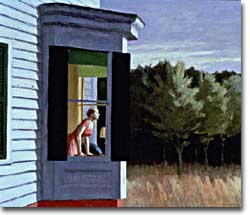
Edward Hopper's Cape Cod Morning (1950) is typical of his lonely, New England scenes depicting a solitary figure. The somber tone of his paintings starkly contrasts with the typical 1950s representations of saccharine, happy-go-lucky American life.
Many in the 1950s strove for the comfort and conformity depicted on such TV shows as Father Knows Best and Leave It to Beaver.
But despite the emerging affluence of the new American middle class, there was poverty, racism, and alienation in America that was rarely depicted on TV.
Minorities seemed to be shut out from the emerging American Dream.
Poverty rates for African Americans were typically double those of their white counterparts. Segregation in the schools, the lack of a political voice, and longstanding racial prejudices stifled the economic advancement of many African Americans. In 1952, Ralph Ellison penned Invisible Man, which pinpointed American indifference to the plight of African Americans. "I am an invisible man," he wrote. "I am invisible, understand, simply because people refuse to see me ..."
Latino Americans languished in urban American barrios, and the Eisenhower Administration responded with a program — derisively named Operation Wetback — designed to deport millions of Mexican Americans .
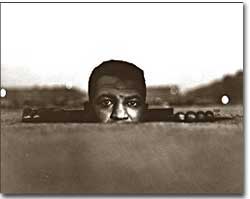
While writing parts of Invisible Man, Ralph Ellison lived at Gordon Parks's home. Parks, a photographer, made a series of prints that were his interpretation of events in Ellison's novel. This one is entitled Man Peeking from Manhole, Harlem (1949).
Reservation poverty increased with the Eisenhower policy of "termination," designed to end federal support for tribes. Incentives such as relocation assistance and job placement were offered to Native Americans who were willing to venture off the reservations and into the cities. Unfortunately, the government excelled at relocation but struggled with job placement, leading to the creation of Native American ghettos in many western cities.
Ethnic minorities — Jews, Italians, Asians, and many groups — all struggled to find their place in the American quilt.
The Beat Generation
In the artistic world, dozens of beat writers reviled middle-class materialism, racism, and uniformity. Other intellectuals were able to detach themselves enough from the American mainstream to review it critically.
The writers of the Beat Generation refused to submit to the conformity of the 1950s. Greenwich Village in New York City was the center of the beat universe. Epitomized by such Columbia University students such Jack Kerouac and Allen Ginsberg, the beats lived a bohemian lifestyle.
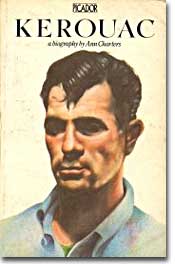
In 1957, Kerouac published On the Road, the definitive Beat Generation novel. The beats were a subculture of young people dissatisfied with the blandness of American culture and its shallow, rampant consumerism.
While mainstream America seemed to ignore African American culture, the beats celebrated it by frequenting jazz clubs and romanticizing their poverty. The use of alcohol and drugs foreshadowed the counterculture of the following decade. Believing that American society was unspeakably repressed, the beats experimented with new sexual lifestyles.
In On the Road, Kerouac's hero travels around the nation, delving into America's fast-living underside. In "Howl," Allen Ginsberg assails materialism and conformity and calls for the unleashing of basic human needs and desires.
As the media helped create a single notion of an idyllic American lifestyle, a vocal minority of social critics registered their dissenting voices. The notion of the white-collar, executive-track, male employee was condemned in fiction in Sloan Wilson's The Man in the Gray Flannel Suit and in commentary in William Whyte's The Organization Man.
The booming postwar defense industry came under fire in C. Wright Mills' The Power Elite. Mills feared that an alliance between military leaders and munitions manufacturers held an unhealthy proportion of power that could ultimately endanger American democracy — a sentiment echoed in President Eisenhower's Farewell Address.
And teen alienation and the neurosis of coming-of-age in postwar America was examined in J.D. Salinger's The Catcher in the Rye.
|
If you really want to hear about it, the first thing you'll probably want to know is where I was born, and what my lousy childhood was like, and how my parents were occupied and all before they had me, and all that David Copperfield kind of crap, but I don't feel like going into it, if you want to know the truth. In the first place, that stuff bores me, and in the second place, my parents would have about two hemorrhages apiece if I told anything pretty personal about them. They're nice and all — I'm not saying that — but they're also touchy as hell. – Holden Caulfield, from The Catcher in the Rye by J.D. Salinger (1951) | ||
Painting against the Tide
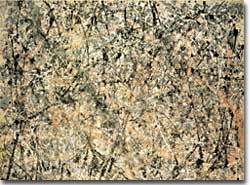
Jackson Pollock's 1950 painting Lavender Mist typifies "Action painting," in which he fixed his canvas to the floor, then dripped paint all over it. Pollock's unorthodox methods were heavily criticized (he was labeled "Jack the Dripper"), but his novel painting style proved that American artists were on par with their European counterparts.
American painters also took shots at conformity. Edward Hopper who had made a name for himself in earlier decades, combated the blissful images of television by showing an America full of loneliness and alienation.
In New York City, painters broke with the conventions of Western art to create abstract expressionism, widely regarded as the most significant artistic movement ever to come out of America. Abstract expressionists, such as Willem de Kooning, Hans Hoffman, Mark Rothko, and Jackson Pollock, sought to express their subconscious and their dissatisfaction with postwar life through unique and innovative paintings. The physical act of painting was almost as important as the work itself. Jackson Pollock gained fame through "action painting" — pouring, dripping, and spattering the paint onto the canvas. Rothko covered his canvas with large rectangles, which he believed conveyed "basic human emotions."
Big Screen Rebels
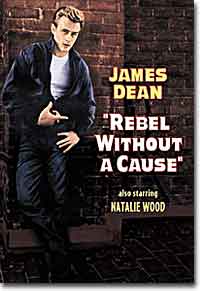
"Rebel without a Cause," a story of anguished middle-class juvenile delinquents, was an instant sensation when released in 1955. The film was particularly scandalous because the main characters "came from good families." James Dean played the main character, Jim Stark.
While the 1950s silver screen lit up mostly with the typical Hollywood fare of Westerns and romances, a handful of films shocked audiences by uncovering the dark side of America's youth. Marlon Brando played the leather-clad leader of a motorcycle gang that ransacks a small town. In 1953's The Wild One. The film terrified adults but fascinated kids, who emulated Brando's style. 1955 saw the release of Blackboard Jungle, a film about juvenile delinquency in an urban high school. It was the first major release to use a rock-and-roll soundtrack and was banned in many areas both for its violent take on high school life and its use of multiracial cast of lead actors.
Perhaps the most controversial and influential of these films is 1955's Rebel without a Cause. Another film about teenage delinquency (the main characters meet at the police station) Rebel is not set amid urban decay, but rather in an affluent suburb. "And they both come from 'good' families!" the film's tagline screamed. Ironically, the film made it clear that the failure of those very families was to blame for the main characters' troubles. Juvenile delinquency was no longer a problem for the lower classes; it was lurking in the supposedly perfect suburbs. Once again parents were outraged, but the message could no longer be ignored. The film earned three Academy Award nominations and propelled James Dean to posthumous but eternal stardom.
Sex Education
Puritanical sexual mores were challenged by Alfred Kinsey's successive reports Sexual Behavior in the Human Male and Sexual Behavior in the Human Female. Kinsey revealed a much greater prevalence of premarital sex, extramarital affairs, and homosexuality than mainstream public discourse would have suggested. Americans were somehow surprised to read that, according to Kinsey, women actually enjoyed sexual experiences as much as men.
Despite the clear presence of poverty, alternative literature, and social criticism, Americans on the whole turned away and enjoyed happy days during the 1950s. But happy days values were soon about to make way for the 1960s.
"You say you want a revolution?"






